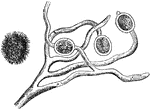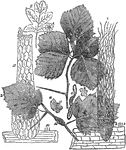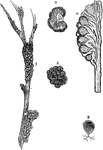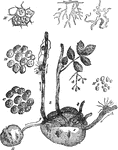Clipart tagged: ‘growth’

Microscopic view of a fermented apple
"Portions of the rotting pulp were placed on a microscopic slide, divided into hundredths and thousandths…

Fungus
Illustration of a fungus named Atrotogus hydnosporus. "Considered by Berkeley and others to be probably…

Stages of fungus growth
This illustration "represents its mycelium growth; 2,2 its budding cells, which terminate in fruit cells;…

Bacteria Growth
"Showing the Effect of Variations in Temperature on Bacteria Growth. a, a single bacterium; b, its progeny…

Cellular structure of peridia
"Under the power of about 90 diameters the general character of the peridia is seen. They are densely…

Black knot of the plum
Illustrations depicting a black knot of a plum. "1...represents the general appearance of the black-knot…

Black knot of the plum
"In answer to a communication of mine, Professor C. H. Peck, botanist, of Albany new York, informs me…

Potato Diseases at a Microscopic Level
"It is not unusual to fine a decayed spot in the center of potatoes otherwise apparently in good condition.…

Potato rot
Illustration of a potato infested with Peronospora infestans also known as 'potato-rot' observed from…

Flowering Sanguinaria
A perennial, herbaceous flowering plant native to eastern North America from Nova Scotia, Canada southward…